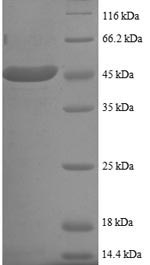CUSABIO synthesized the recombinant gene by integrating the N-terminal GST tag sequence into the targeted gene encoding the 1-157aa of the human UBE2I. The synthesized gene was subsequently cloned into an expression vector. After cloning, the expression vector was introduced into the E.coli for expression. The product was purified to obtain the recombinant human UBE2I protein carrying N-terminal GST tag. The SDS-PAGE assayed the purity of this recombinant UBE2I protein greater than 90%. This UBE2I protein migrated along the gel to a band of about 45 kDa molecular weight.
UBE2I is a gene providing instruction of making a protein named SUMO-conjugating enzyme UBC9 (also called Ubiquitin-protein ligase I and abbreviated as p18) in human and belongs to Ubiquitin-conjugating enzyme family. SUMO is an abbreviated form of small ubiquitin-like modifiers. SUMOylation is a process of covalent and reversible attaching of SUMO moiety to a target protein and is an important post-translational modification involved in various cellular processes. UBC9 is the unique SUMO E2 enzyme known ro conjugate SUMO to target substrates. The UBC9 serves as a lynchpin in the SUMO conjugateion pathway, interecting with the SUMO E1 during activation.




